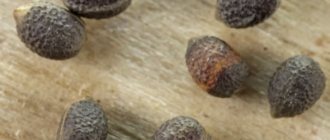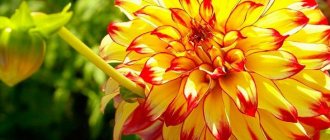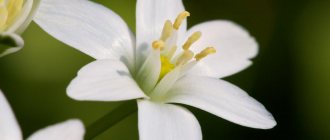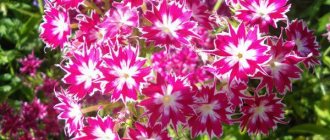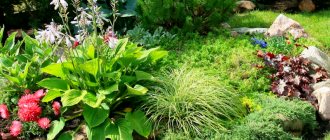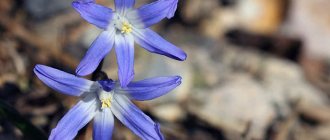The perennial daisy plant (Bellis) is a member of the Asteraceae (Asteraceae) family. This genus includes 14 species. In the wild, this flowering plant is found in the Mediterranean. The ancient Greek word “margarites” means “pearl”, this is due to the fact that the wild daisy has small white flowers. The Latin name for the plant was given by Pliny, it translates as “beautiful, beautiful.” In some countries, the daisy is called the “eye of the day” because the opening of its flowers is observed directly during sunrise. If you translate this name into English, it will sound like “daisy eye”; in this regard, the British affectionately call this plant by the diminutive name Daisy. German girls used daisies instead of daisies for fortune telling, tearing off their petals, in connection with this, the daisy-daisy began to be called in Germany the “measure of love.” This flower culture has been very popular among gardeners for many years, so a large number of tales and legends have been invented about daisies. These flowers have almost always been considered very fashionable, since when they bloom they look impressive and cute.
Daisy flowers: varieties, description, what they look like?
Daisies belong to the Astrov family. This plant is native to Australia, Europe and America. Almost all modern species of these flowers originate from one species, Perennial Daisy.
Garden daisies develop a rosette in the first year. In the second year, peduncles appear that reach a height of 20-30 cm. Beautiful inflorescences-baskets appear on each peduncle. The number of such inflorescences on one plant can reach 25-30 pieces.
Gardeners use about 30 species of daisies. There are early and late varieties. In addition, daisies can have inflorescences of different shapes and sizes. Flower growers are especially fond of double varieties of daisies.
The most popular varietal series are:
- "Rominette" An early form of daisies. Large, densely double inflorescences are among the first to appear in the garden. These daisies can be planted in flower beds and borders. When planted in groups, these daisies can be used to create a beautiful thick carpet. They are also used in container gardening.
This type of daisy can be painted in one of four colors.
The most popular is “Carmine Rose”
- "Habanera" Another very popular type of double daisies. White Visa Red , painted white with a red tip .
This variety of daisies looks great next to ferns and low-growing conifers. White Visan Red daisies are combined with early tulips, forget-me-nots and some varieties of hyacinths.
- "Tasso" Unlike previous series, daisies of this type have pompom-shaped baskets. Tasso daisies usually bloom early and are compact in size. Most varieties of this species can be used as carpet plants.
There are red, pink and white varieties of Tasso. They prefer sunny open places, but in hot weather direct sunlight can depress the plant. With proper preparation, they tolerate winter cold well.
- "Robella" A variety that was bred not so long ago. Daisies of this variety have salmon-pink terry baskets of folded flowers. Rarely reach a height of 15 cm. This variety was awarded the highest award by the International Organization of Ornamental Floriculture.
Robella daisies will look beautiful in flowerpots, on a rocky hill and in the foreground of a mixborder. This variety of daisies can be combined with tulips, forget-me-nots, daffodils and violas.
Also popular among Russian flower growers is the Pomponette . It is distinguished by bulbous flowers.
Etna daisies have orange centers and dark purple petals.
Schneebel variety is known for the fact that up to 20 large pom-pom flowers are formed on one bush.
The most popular early daisy variety is Rosa Gigantea . And later “Beethoven” . For container keeping or indoor forcing, daisies of the varieties “Dresden China” and “The Pearl” .
Popular varieties
The daisy is a charming spring flower, striking in its richness of colors and shapes of inflorescences. Garden stores sell different varieties that differ in shape, size and color. The most popular varieties are those with large and semi-double flowers.
Depending on the variety, the plant forms inflorescences with different petal structures: some are wide and large, others are small and rolled into a tube.
Pomponette
A popular and beautiful variety of daisies is the pomponette. This is an unusual spring flower, producing original, pubescent, small pompom-shaped flowers. It reaches a height of 15-20 cm and has ovate, slightly toothed leaves that form rosettes. Flowering stems are slightly hairy. It has a very long flowering period, from April to July.
Super Enorma
One of the most famous varieties, suitable for growing in beds, flower beds, pots, and decorative containers. Can be grown in partial shade but will bloom profusely in full sun.
Habanera Red White
It is worth paying attention to the Habanera Red White variety with original, vertical, completely white flowers with characteristic red tips.
Speedstar Red
Speedstar Red is 10-13 cm high with semi-double, yellow flowers in the center. Used as a ground cover plant, in flower beds and rock gardens.
Rominette
A series of varieties with purple flowers. For example, the rose Rominette Rosa with purple-pink flowers.
Daisy flowers: legends and beliefs
The word "daisy" is derived from the word "margarites". Which means “pearl” in Greek. According to one legend, the little Virgin Mary loved to look at the sky in the evenings. She wanted the stars to become flowers that she could play with. The stars sparkled in the droplets of emerging dew like pearls. And the next day, in place of the dew drops, beautiful flowers appeared - daisies.
Russian legends also mention this flower and pearls. The legend about Sadko says that when he came ashore, his wife Lyubava rushed to her lover and scattered her pearl necklace. In the places where the pearls fell, daisies appeared.
The daisy is sung by many poets. Shakespeare said about this flower, “Her white robe represents naivety.” Pliny called this flower Bellis "beautiful". This is the word used today to call the genus of this flower.
Daisies are revered throughout Europe. In France, it is customary to give these flowers a week before Easter (analogous to our Palm Sunday). Daisies decorate the windows of houses, gardens and parks. It’s a pity, but today these beautiful flowers are gradually being replaced by tulips, daffodils and hyacinths.
Daisies are very popular in England. Songs and legends are dedicated to them. With their help, girls tell fortunes by tearing off the petals of a daisy “loves or dislikes.” In German culture, this is why daisies are called “the measure of love.” And boys, for the quick onset of spring, they must step on 12 forget-me-nots.
Flower of Love
Medieval knights, who received consent for marriage from their lovers, placed an image of this flower on their shields. Most likely, this legend is associated with Countess Margaret, who gave this flower to Count Orlando before going on the Crusade. The count fell in battle, but his friends brought a flower to his beloved. It was stained with the blood of Count Orlando. Margarita planted the seeds of this flower in memory of her beloved.
Since daisies are the first to bloom in the garden, they are also called the “Day's eye”. The English shorten the name of daisies to Daisy .
There is another legend associated with this flower. One rich old man fell in love with a beautiful but young girl. Her poor parents were not averse to giving their daughter in marriage to a rich old man. But the girl didn’t want this and ran away. And in order not to be found, she asked the earth to hide her. The earth turned the girl into a daisy that blooms all year round.
At the beginning of the 20th century in Europe, daisies were used to raise money to fight tuberculosis. This experience was first gained in Sweden, where these popular flowers were sold and the proceeds were donated to hospitals. Later other European countries joined in. In Moscow, such an action was carried out in 1910. The sale of daisies generated 150 thousand rubles. Russian newspapers were full of headlines that Muscovites “threw flowers at death.”
Surprisingly, with such a love for daisies, these flowers also had a black stripe. In 1739 in Germany they were called poisonous and called for extermination. But daisies survived and delight us today with their magnificent beauty.
Historical information and name
Hemlock was first classified in scientific literature in 1763 by Carl Linnaeus, in the second edition of Species plantarum.
.
He gave it the name Pinus canadensis. The modern name Tsuga canadensis was given to the tree by Elie-Abel Carriere in his work “Traité général des conifères”
in 1855.
Its generic name is Tsuga
the tree received the Japanese name of one of the local species.
The specific epithet canadensis
is translated from Latin as “Canadian” and indicates its natural range.
Plant name in other languages
| Language | Name |
| English | Eastern Hemlock, Canadian Hemlock, Hemlock Spruce |
| Hungarian | Kanadai hemlokfenyő |
| Dutch | Oostelijke hemlockspar |
| Danish | Østamerikansk Hemlock |
| Italian | Abete del Canada |
| Lithuanian | Kanadinė cūga |
| German | Kanadische Hemlocktanne |
| Polish | Choina kanadyjska |
| Finnish | Kanadanhemlokki |
| French | Pruche du Canada, Tsuga du Canada |
| Czech | Jedlovec kanadský |
When to sow daisies in open ground?
Daisies are quite unpretentious plants. They feel good on any composition. The exception may be soils that are excessively acidic and alkaline. A sunny area of the garden is best for daisies. These flowers, blocked by bushes or trees, feel worse than those that receive more light.
It is also important that the soil has good drainage. After clearing the ground of debris, pebbles and plant roots. Today you can buy regular daisy seeds or so-called panned daisies. Such seeds are covered with a special coating that contains nutrients and protects the seeds from pests.
If you are planting pelleted daisy seeds, it is very important to frequently water the area in which the seeds are sown. Water will gradually dissolve the shell and the sprout will sprout faster.
Regular seeds are best planted in open ground in March. When the soil warms up to the desired temperature (15–20°C). It is best to scatter the seeds evenly over the area and sprinkle with a small layer of sand or peat. If you plant daisies in holes, there is a risk of planting them at a depth that is too deep for these flowers. This will not only increase germination time, but can also lead to the death of the plant.
The planting site for daisies should be covered with film to create a “greenhouse effect.” Remove the film after 2-3 days. The soil should not be allowed to dry out. With proper care, plants planted in this way appear in 1.5-2 weeks.
Features of the daisy
Daisy is a small herbaceous plant with a short rhizome. The basal leaf plates are obtuse, spatulate, crenate. The stem is leafless and only 1 head is formed on it. The development of ligulate female flowers, which are pink or white in color, occurs on a conical receptacle. The middle flowers are tubular, bisexual, and they are colored yellow. For those daisies that are grown by gardeners, the inflorescences can vary not only in size, but can also be double, semi-double or simple. The fruit is a flattened achene without a tuft.
Daisy: cultivation and care
Caring for daisies in the open ground
Daisies are easy to care for. They prefer excess moisture in the soil rather than a lack of it. It is advisable to periodically loosen the soil between the bushes and water 0.5 liters of water under each plant. If the soil in which they grow becomes dry, then when they bloom, the diameter of the daisies may become smaller than usual. Also, lack of moisture can affect terry. She might disappear.
For good growth and vigorous flowering, it is advisable to feed daisies. You can use the following solution: Nitrophoska (2 tablespoons), Agricola-Fantasy fertilizer (2 tablespoons) and water (10 liters). Each bush needs 1 liter of this fertilizer. A solution of bird droppings or mullein also works well.
As for daisy diseases, these flowers are less susceptible to them than other plants. The greatest dangers to daisies are caterpillars and slugs. You can fight them with the “Hom” solution.
Daisies can also be susceptible to gray mold, powdery mildew or rust. At the first signs of these diseases, flowers should be treated with Topaz.
In winter, to prevent low temperatures from causing the daisy bushes to freeze, they should be sprinkled with peat, leaves, humus or snow.
Perennial daisy after flowering
Collecting seeds
The ripening of daisy seeds is observed at different times, that is, they do not ripen at the same time. In this regard, they must be collected gradually, or rather, 1 or 2 times every 7 days. Cut off the required amount of wilted inflorescences, and try to do this before the ripened seeds are washed away by rain or a stream of water during watering. The seeds should be removed from the inflorescence and distributed on the surface of a paper sheet. To dry them, place them in a well-ventilated area. Dried seeds are poured into paper bags, which are placed in a dark and dry place where they will be stored.
How to prepare for winter
In order to protect the surface system of daisy roots from severe winter frosts, especially if not a very large amount of snow is expected to fall, the surface of the site must be covered with a thick layer of mulch (humus, sawdust, peat, etc.). The thickness of the mulch layer should be such that it is no thinner than 80 mm. If the bushes begin to protrude from the soil, during which their roots are exposed, the need for mulching the area increases. In spring, these bushes will need to be transplanted to a new place at a depth more suitable for them.
Daisies care / low-growing perennial flowers
How to grow daisies on a windowsill or balcony in a pot?
You can also grow daisies at home. The easiest way to do this is to dig up a bush of these flowers from your garden and plant it in a large pot. This is best done in the fall, when the average day temperature drops to +8 degrees.
Daisy in pots
Prepare a bud favorable for this flower. It should be loose and fertile. Add humus and sand to this soil. The pot with the transplanted plant should be placed near the window. Then the daisies will receive the required amount of light and will bloom in December.
If you plant daisies in pots made from seeds, they will begin to bloom only the next year. The best time to plant seeds of this flower is March-April. Pots or boxes with seedlings should be placed in a sunny window and watered moderately.
When the seedlings have their first true leaves, they can be planted in separate pots or transplanted into containers with several seedlings each. When rosettes appear, daisies can be grown like other house flowers.
In order for daisies to bloom profusely next year, they need to be placed in a cool place in November and watering reduced to a minimum. At the end of February, the plants are placed on the windowsill again and watered as normal.
For a flower garden planted on a balcony, it is best to choose special containers for daisies, which are sold in hardware stores. And in order not to waste time watering these plants, you can buy and install special automatic systems for moistening the soil.
Diseases and pests
Like any plant in the garden, daisies are susceptible to disease and attack by pests . If you do not help the plant in the fight against them, then over time the trunk will be completely lost, and the infection will spread further.
"Murder" of a blooming daisy
To avoid such an outcome and preserve all available types and varieties of flowers in the garden, it is worth learning to distinguish between ailments. The correctly selected method of control will also be important, because the future fate of the plant largely depends on the drugs used.
Most often, daisies and other garden plants suffer from:
Thrips These are small brown or yellowish insects that choose the lower part of plant leaves as their location. Their presence is signaled by dark secretions throughout the plant; in addition, the leaves acquire a yellowish-brown color, which spreads chaotically and does not lie evenly.
To rid the plant of this nuisance, all infected trunks, as well as nearby plants, should be treated with insecticides. It is advisable to carry out preventive treatment 5-7 days after the first treatment.
Powdery mildew A whitish powdery coating on leaves and flowers indicates that the plant is suffering from powdery mildew. There are not many methods of control; fungicides fight the disease best.
You will have to process it several times at intervals of 6-9 days.
Brown spot Manifests itself in the formation of parchment-like spots on the leaves. They quickly spread throughout the bush, so you need to act without delay. The main reason for its occurrence is increased soil and air humidity; in order to preserve the trunk, it is worth digging it up.
Dry thoroughly and plant in looser soil in a ventilated place.
Gray rot In warm, damp weather, daisies in the garden can be affected by gray rot; it is most often observed on trunks in autumn and spring. You can avoid the disease or reduce the possibility of its occurrence by completely cutting off the old leaves on the trunk for the winter; the correctly chosen planting location also has a significant influence.
If a disease is detected, it is worth treating the affected areas with Fundazol.
caterpillars are enjoyed by many species of caterpillars and eat their leaves with a special appetite. You can fight them in several ways, either regularly collect them by hand in the evening, or periodically treat them with insecticides.
Before you start working with drugs that help you cope with these pests, be sure to read the instructions and strictly adhere to safety precautions.
Growing Daisies: Tips and Reviews
Natalia. Very beautiful flowers. But they need constant watering. Their root system is located almost on the surface and if the soil dries out, the roots can be damaged. And this arrangement of roots does not allow them to withstand dry days. We are only at the dacha on weekends. Somehow we left and forgot to water it. It was a dry week and our daisies withered.
Svetlana. Very beautiful flowers. But I heard that they are also very useful. Based on them, you can make decoctions that help with bronchitis and kidney disease.
Reproduction
Garden daisies are usually purchased at garden centers as already blooming spring flowers. However, it is worth trying to grow your own daisies from seed or vegetatively.
Seeds
In this way, you can get a lot of young plants that will decorate your garden or balcony next year.
It is best to buy seeds for sowing at a garden store. They are obtained through selective breeding, so you get exactly the plants you want.
When to sow daisy seeds? It is best to sow the seeds in June so that they have time to grow before autumn. The ideal temperature for seed germination is 18 °C.
Seeds are sown in the garden as follows:
- Prepare a small area for seedlings, which you first clear of weeds, loosen the soil, dig it up, adding compost.
- The soil is carefully leveled with a rake.
- Make shallow furrows (1 cm) and sow seeds in them.
- Cover the seeds with a light layer of soil and keep the soil moist. Be sure to weed the seedlings regularly.
- When the plants have 3-4 leaves, cut them off one at a time to create the best conditions for further development.
- In late August and September, young daisies are ready to be planted at their destination. Daisy seedlings are planted in a fixed place at an interval of 20 × 20 cm.
- For successful cultivation, young plants must be protected from frost during the winter. Use branches of coniferous trees.
The resulting plants can be used to frame flower beds, paths and lawns. They will look great as potted flowers and will be a wonderful decoration for balconies and at home. Garden daisies grown from seed will bloom next spring.
Vegetatively
Daisies can be propagated vegetatively. In the spring, break off the shoots from which the mother bush grows, plant them in the ground and place them in a warm place. Young plants should be watered regularly. To create optimal rooting conditions, use a plastic tent over the pot with cuttings. This will reduce water evaporation and ensure constant substrate moisture. The cuttings take root quickly and young plants appear within a few weeks.
Daisies can also be propagated by division. Carefully dig up a few rosettes with roots. Dig up the plants with their entire root system, which goes quite deep into the ground. When you move them to their destination, make sure the holes are deep enough to keep all the roots hidden in the soil. It is best to first prepare holes in several areas of the lawn into which to pour soil for planting. Then small flowers are planted in the holes.
Next year, dozens of new flowers should appear, which will multiply consistently from year to year. New plants can be brought into the garden from natural meadows, they are extremely weather-resistant, frost-resistant and have a really long flowering period.
Wintering
Perennial daisies are considered frost-resistant crops, but the root system of the plants needs additional protection.
In order to prepare the flower for the winter period, the following procedures are carried out:
- In late autumn, plants with exposed roots are replanted. When planted correctly, only shoots remain on the surface of the earth.
- Unlike other crops, daisy leaves and buds are not cut off for the winter, but rather the bush is sprinkled with a layer (up to 10 cm) of dry grass or spruce branches.
- Additionally (on top of the foliage) mulching is carried out with a centimeter layer of humus.
Using these methods will help protect the daisy from freezing its roots.
In the foreground
The perennial daisy is the star of the foreground. With a colorful stripe, it emphasizes the geometry of flower beds; it spreads like a carpet along garden paths, maintaining the border with the lawn and generously spilling colors in front of taller garden flowers.
Bellis perennis
This is a perennial plant 10-30 cm tall with a basal rosette of spatulate leaves and a bouquet of “daisies” on short leafless peduncles. Growing daisies from seeds in a biennial culture is widely practiced. The inflorescence is a basket. The large outer “petals” are ligulate flat or tubular flowers. The center of the basket - a golden-yellow disk - consists of small tubular flowers. The structure of the basket underlies the division of varieties into reed and tubular, which, in turn, are divided into terry, semi-double and simple.
Terry varieties are very impressive
The daisy was among the first wildflowers to make its way into the gardens. Already in the 16th century, there were terry varieties, not only white, but also red.
Variety Confetti Duck Pink
Daisies are wonderful companions for tulips, daffodils and other spring bulbs.
Step-by-step planting instructions
Most gardeners tend to grow daisies as a 2-year plant. If you follow the suggested instructions, in the last week of April you will be able to enjoy lush flowering that lasts until the first frost. Both seeds and seedlings are planted in open ground. The article discusses both options.
The first wave of flowering of many varieties begins in early spring
Photo 5. It is advisable to plant perennial crops in the garden.
Step 1. Selecting a variety
Among the most popular, there are two types of varieties.
Reed:
- Bellisima. It reaches a height of 15 cm. Double flowers are arranged in pom-pom-shaped baskets. The diameter of the inflorescences is up to 4.5 cm. The color of the petals is pink or scarlet.
- Rominette. Small, grows only up to 12 cm. Densely double inflorescences rest on powerful peduncles. Carmine-colored flowers.
- Pomponetti. The variety, bred by French breeders, has miniature inflorescences. During the flowering period, up to 40 flowers are formed on one crop.
- Speedstar. The height of this variety is about 13 cm. The petals are semi-double, predominantly yellow. Flowering occurs in the year the seed is planted. The petals are painted in soft pink, snow-white or carmine colors.
- Habanera. The owner of large double inflorescences with a diameter of up to 6 cm. Externally similar to asters. Flowering begins in early June.
Tubular:
- Rosabella. Large double inflorescences are painted in a salmon shade. The diameter of the flowers is about 5 cm.
- Bella Daisy. Characterized by early flowering. The flowers are arranged in a pink terry basket, the diameter of which does not exceed 2.5 cm.
- Robella. The height of the plant is 15 cm. The color of the petals ranges from coral to pale pink. The diameter of terry baskets is up to 5 cm.
- Rob Roy. The culture is small in size, reaching only 10 cm in height. Miniature inflorescences, up to 2 cm in diameter, are painted in a rich scarlet color.
- Tosso. The owner of large inflorescences, up to 6 cm in diameter. Pink, scarlet and snow-white inflorescences form baskets tightly fastened to each other.
Step 2. Determining the time of sowing
Seeds are placed in open ground in June. If you plan to grow by seedling method, then the seed is sown in containers in February or March, and the sprouts are transferred to the soil in the fall. This method allows you to achieve the first wave of flowering in the current season.
It is better to sow seedlings in February
Step 3. Select a location
The plant belongs to the light-loving category. However, slight shading is not a problem. In a dark area it will not delight with lush flowering, but the flower stalks will be tall and the leaves will be delicate. The sun promotes intensive formation of inflorescences, but the plants will be short. The optimal location is one that is not exposed to midday rays.
Due to the fact that daisies react negatively to dampness, you should check that groundwater does not pass directly to the surface.
The area for cultivating daisies should not be in the shade
Step 4. Preparing the soil
The soil must be properly cultivated and drained. Optimal pH values are from 5.8 to 6.2. The priority is structured, light loams. They give plants the necessary amount of moisture. When planning to grow this crop, it is advisable to feed the soil with rotted cow manure in the fall.
For these plants, excessively moist soil is more dangerous than dry soil. In places where meltwater stagnates, daisies fall out of the ground. To avoid this, the soil must be drained.
Mullein for fertilizer
Step 5. Preparing seed material
Species daisies reproduce well using seeds. For cultivation, both purchased and hand-collected planting material is used.
When collecting independently, you cannot take seeds from hybrids. The plant may lose its original characteristics. This applies to the color of the petals, the diameter of the inflorescences and the growth of the crop.
Collecting seeds after flowering
- This is done gradually, several times a week.
- The weather should be clear before the onset of seasonal rains.
- The required number of wilted baskets is cut off.
- The seeds are removed and placed on a white sheet of paper.
- Placed in a room with good ventilation.
- When dry, put into paper bags.
Daisy seeds are very small, 1 g contains up to 1,600 pieces.
Botanical description of the culture
It grows mainly in Mediterranean countries and western Europe. In garden design it performs several functions:
- frames flower beds;
- forms “carpet paths”;
- makes the border with the lawn more decorative.
There are about 15 varieties of daisies known. Gardeners cultivate both annuals growing in pots and perennials growing in gardens.
Daisies go well with daffodils, tulips and other bulbous plants.
The most common colors are pink, red and snow-white.
From the ancient Greek language the word “margarites” is translated as “pearl”. This association is associated with the appearance of the wild version of the plant. From afar, small snow-white flowers look like the contents of mollusk shells. In a number of countries the plant is called the “Eye of the Day”. This is due to the fact that the flowers open at the same time as the sun rises.
Daisies are in great demand in creating garden compositions.
Daisies have phenomenal meteorological abilities. Before the rain, the inflorescences close and the stems are pressed tightly to the ground.
Table 1. Main characteristics
The daisy is the first wildflower to migrate to the garden
Growing seedlings
In this case, the plants will bloom in a few months. I advise you to sow seeds for seedlings in early February. Choose spacious containers with drainage holes. Daisies do well in soil intended for flowers. It can be purchased at a specialty store.
Seeds are sown according to the same principle as in the garden. They germinate quickly at a temperature of + 23 degrees. Keep planting material under bright, indirect light. When you see shoots, lower the air temperature to + 13 degrees.
Seedlings should be in the light. I recommend illuminating them using fluorescent lamps (must be on for 11 hours).
Collecting seeds
Daisy seeds do not give away all at once, but as they ripen during a long flowering period, so if you want to collect all the seed material, you need to do this in stages every 5-7 days. It is necessary to carefully cut off the already wilted but not yet scattered seeds of the inflorescence, shake them out onto paper and lay them out on it to dry. For storage, paper envelopes or bags are also used, which are left in a dry and dark place for the winter.
Before harvesting, do not water the daisies; jets of water can easily wash away the ripe seeds.
Spectacular variety
The scientific name of the perennial daisy, Bellis perennis, translates to “beautiful perennial.” In the 17th century, two-color daisies appeared with speckled petals and stripes, red on the top and white on the bottom. In Italy, varieties with pointed baskets of tubular flowers were bred. Button daisies with small pompom baskets 'Pomponette' were given to us by France.
Daisies with small pompom baskets Pomponette
These days, the color scheme has expanded to rich dark reds and salmon pinks.
The dark red hue is sure to attract everyone's attention.
There are small varieties, such as 'Dresden China', 'Liliput', 'Alice', and giant varieties, such as 'Habanera'.
Charming little ones are an essential element of English cottage gardens.
In the curious variety 'Prolifera', also known as 'Hens and Chickens', the central basket is overgrown with a "halo" of small second-order baskets, like a hen surrounded by chicks. (Depending on the length of the stems, this floral wonder looks like an elegant wreath of individual mini-daisies above the “mother” basket, or like a single, but large and shaggy double daisy.) In daisies, the phenomenon of proliferation - the germination of inflorescences - attracted attention already in XVI century, as recorded in the illustrations of ancient garden encyclopedias. It is surprising that the variety has survived to this day, although now this rarity is grown more for fun.
There are also daisies with unusual leaves - 'Aucubaefolia' with yellow splashes on the leaves, like the houseplant aucuba, and 'Shrewley Gold' with a bright golden-yellow pattern along the veins.


